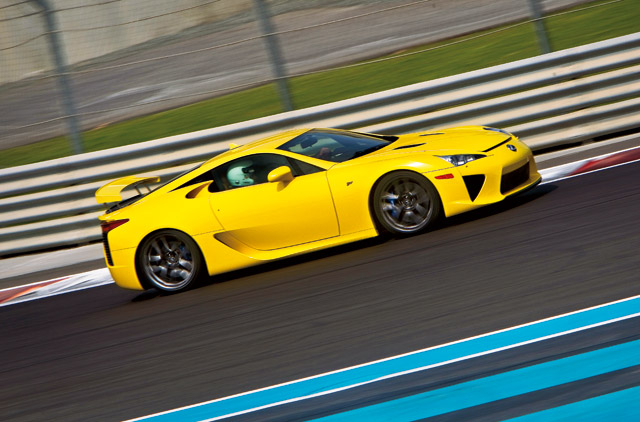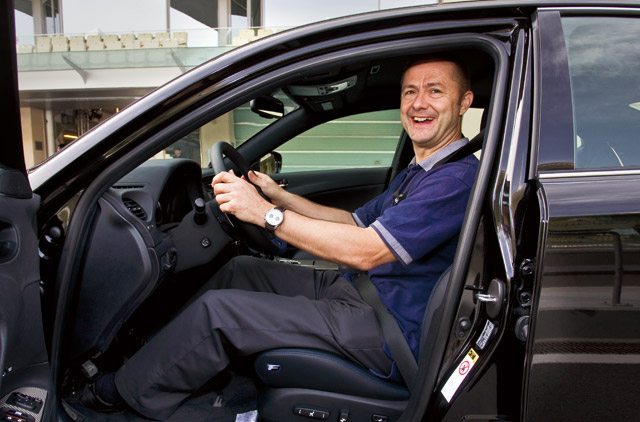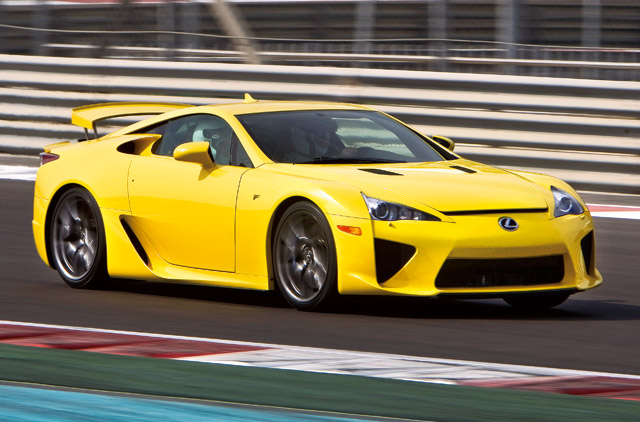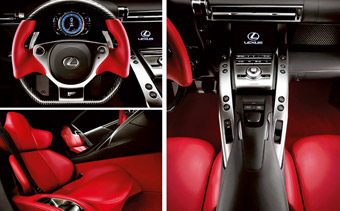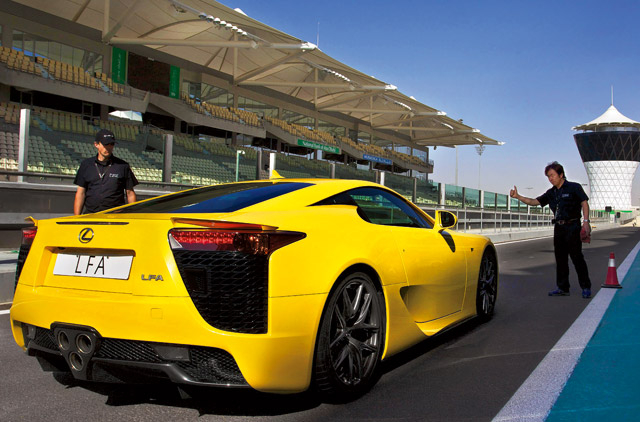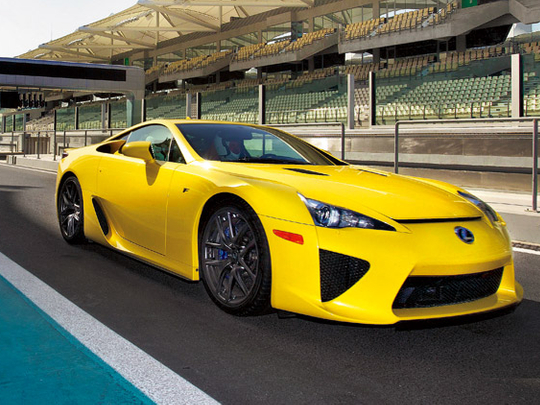
Our editor Amit left me with two choices: enjoy my usual Friday morning routine of a long lie-in and lazy breakfast, or get up at 6.30am, drive to Yas Marina for 8.15am, strap a Dh1,600,000 Lexus LFA onto my back and drive it as hard as I could around a racetrack. I thought about it for 0.6 seconds. The same length of time it takes the LFA's 4.8 litre V10, 552bhp, hand-built dry sump engine with titanium conrods and ten independently controlled throttle bodies, to race from zero to 9,000rpm.
"I don't know Amit, my parents are over from the UK and I promised to take them sightseeing on Friday". There was a 3.7 second pause in the conversation. The exact time which is needed to accelerate the LFA from 0-100kph down the longest straight in Formula 1, with the fiendish wail of its soprano exhaust notes screaming off the walls of the North grandstand, as the track, armco, marshals' posts, and catch fencing hurtle past the windscreen in a blur of tarmac, concrete and steel.
What the heck, the lobby of the Yas Marina Hotel counts as ‘sightseeing', right? My dad understood. And he assures me that my mother will probably speak to me again before they leave.
What's devotion in Japanese?
The LFA has been 10 years in the design stage, but the concept changed radically in 2005 when chief engineer Haruhiko Tanahashi decided to switch from an aluminium structure to one of carbon fibre. The result is a front engined, rear-wheel drive car with exceptional rigidity which weighs in at 1,480kg, giving it a power-to-weight ratio of almost 350bhp-per-tonne. And whilst there are exotica out there with better figures, ask yourself if they have air conditioning and seat-belts with built in airbags. Thought so.
This is no bare bones stripped out supercar built by a manufacturer which charges extra for removing the carpets and door trim. Nope, this is a comfortable, leather or Alcantara trimmed work space, with plenty of carbon fibre on display, but enough satin finished metal and accent stitching to qualify as a Lexus.
An optional Mark Levinson sound system is available, but if you stick with Lexus's own, you'll benefit from a "317 per cent increase in output, a 37 per cent decrease in weight, and a 35 per cent size reduction". So there you have it. In car entertainment that's 37 per cent lighter. This is clearly a vehicle specified by engineers and built for enthusiasts. Which goes some way to explaining the price tag.
Switch on the ignition, press the start button mounted on the carbon fibre, flat bottomed steering wheel, and suddenly the choice of sound system is irrelevant. There isn't an MP3 file on earth that sounds better than a V10 on full chat, and Tanahashi, who was on hand at the test drive, told me that the LFA team went to great lengths to perfect the aural experience.
The sound of both induction and exhaust are directed to reach the cockpit ‘just so', whilst there are elements in the car's structure which exist merely to fine-tune the bass notes. Like I said — this is an ‘engine ears' car, and the effect is intoxicating.
After two laps of tuition in the LFA as a passenger, it was finally time for me to be let loose at the controls. Fortunately we were using the North Circuit with which I'm at least vaguely familiar, but my hopes of taking the LFA to its maximum speed of 325kph were scuppered by the inclusion of the chicane in the back straight. Foiled again.
Engaging first gear and pulling away gently… is impossible. Give a grown man 552bhp under his right foot and the word ‘gently' has no relevance. In the couple of seconds before I first looked down at the digital tachometer — apparently an analogue one wouldn't keep pace with the free revving V10 — my speed had reached 70kph and I was dropping down into the pit tunnel. I then barely touched the brake pedal and embarrassingly came almost to a standstill. "That'll be the Brembo callipers and 390mm carbon ceramic brake discs at work Mr Ansell," said my instructor. But I couldn't hear him; take an exhaust note honed to perfection and amplify it within tunnel walls. Sorry Mr Levinson, but I have no need for your woofers or tweeters.
Emerging from the tunnel I put my foot down in anger for the first time. "Oh my…" I suppose the LFA might accelerate faster if you pushed it out the back of a Hercules at 6,000m.
Since there were no other cars on the track, I cut the exit line slightly and put the hammer down again, coming over the brow of a slight rise and dropping down toward the first chicane. I'd comment on the ride comfort but frankly, this car cries out to be driven on roads only when they are the shortest point between two circuits. There was never any discomfort — the excellent padded and supportive seats are a far cry from the sheets of carbon fibre described as seats in the Alfa Romeo 8C Spider for example — and they're electrically adjustable. And yet no compromises have been made when it comes to road holding or body roll. There's a surplus of the former, and none of the latter.
Despite those astonishing brakes, I'm so enjoying the experience that I leave the braking a touch too late on entry, mess up my line for the right hand exit and am slow on the approach to the following hairpin. To be honest I can't recall my speed, because I was solely focused on not braking too late again.
The reason being that the fastest line involves driving as hard as you can directly towards the base of the North grandstand, leaving the brakes well alone and trying to pretend you're not hurtling toward an unyielding concrete structure. Quite literally at the last second you stand on the anchors, turn hard into the left hander and, smooth as you can, release the fury of that awesome V10 down the straight.
But I'm on the brakes too soon (I wonder why!?), setting an unimpressive pace through the hairpin, and anyway the lightly loaded steering catches me out and I have to widen my turn halfway through the bend. This is not going well — but it's not the LFA's fault. With only four more laps available to me in the time I'm given, I concentrate on wringing the most out of this fabulous vehicle without acting like a complete hooligan. It's so tempting to leave the gear changes just a touch later than the optimum, not only because of the wonderful noise you're assaulted with at 8,000rpm, but because the single plate auto sequential gearbox is really quite brutal.
You can dial in the speed at which it changes gears to as low as 0.2 and one second but the Lexus crew had naturally set it to 0.2. Consequently there was a distinct thunk behind me each time the rear transaxle performed its magic. Don't misunderstand me, the gear change isn't agricultural. I would imagine that mechanically it's pretty much perfect, but it's not subtle.
Gradually I learned to accept that the LFA can be turned into a corner faster than my self-preservation instinct gave it credit for, and my late braking became less of a problem than my lack of nerve.
The LFA rides on a classic double wishbone front suspension and multi-link at the rear, dampers are monotube coilovers and weight distribution is 48:52 front to rear. The result is a superbly balanced vehicle that pretty much does what you would expect — and hope — it would, and if you pour the power on early, you are rewarded with deliciously controllable oversteer. I know my limits on a track and the LFA allowed me to explore them a few times without indulging in the ritual humiliation of its driver.
And then it happened. With a handful of laps under my belt and greater familiarity with both the car and the circuit, I nailed the double left hander at the end of the straight. If you get the entry point and degree of turn just right, you make them as one long turn under hard acceleration, popping out onto the shortest of straights before turning right down the starting grid between the main grandstands.
Getting it absolutely right was hugely satisfying, but the LFA punished my smugness when I then completely missed a gear change on the exit of turn one. I'm used to driving a car in which the gear paddles rotate with the wheel, so they are always in the same place under my finger tips. However in the LFA they are fixed in the nine and three o'clock positions, and I found myself snatching at thin air on more than one occasion. It's embarrassing, but blaming the car is pointless, I just have to learn to adapt.
Verdict
And why not adapt? The LFA is a wonderful driver's car with sufficient creature comforts to keep a passenger happy too. It entertains the senses and rewards enthusiastic driving without harshly biting its owner.
So it's not a Lamborghini, or Ferrari, or Pagani. If you can look past the badge and accept the LFA as an engineering master class, then it's a supercar by any definition.
Perhaps the final word on the LFA should go to my parents. Dad liked it, he said he thought it looked and sounded ‘purposeful'. And mum? Well I'll get back to you on that. Just as soon as she's talking to me again.
While the LFA is ludicrously expensive, Lexus doesn't really care. Because the LFA's numbers are so exclusive (only 20 are made per month), this is merely meant to be a demonstration of Lexus's might and engineering genius.
Specs & ratings
- Model LFA
- Engine 4.8-litre V10
- Transmission Six-speed auto, RWD
- Max power 552bhp @ 8,700rpm
- Max torque 480Nm @ 6,800rpm
- Top speed 325kph
- 0-100kph 3.7sec
- Price Dh1.6m
- Plus Incredible engine, RWD chassis, build quality
- Minus Price


